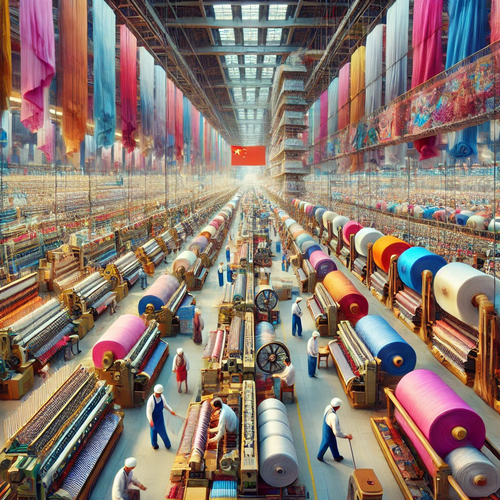
China is a world leader in textile manufacturing and exports, playing an important role in the global economy. The sector covers a wide range of products including clothing, fabrics, home textiles and technical fabrics. China's textile industry continues to develop and modernize, introducing new technologies and approaches to sustainable production.
Key areas of China's textile sector:
1. Scale and production of clothing
China is the largest clothing manufacturer in the world, with a variety of products, from the mass segment to high-quality brands. The country continues to meet global clothing demand by providing supplies to established international brands and retailers.
2. Textile Technology and Innovation
China is actively innovating in the textile industry, including the use of automation, robotic technology and digital platforms to control manufacturing processes. Technologies such as 3D fabric printing and intelligent materials are becoming important components of the industry's modernization.
3. Sustainable Manufacturing and Environmental Initiatives
In recent years, China has increasingly focused on sustainability in textile manufacturing. The introduction of environmentally friendly technologies such as recycling, the use of organic fabrics and reducing environmental impacts is becoming a priority for many Chinese producers.
4. Development of synthetic and technical fabrics
China is actively developing the production of synthetic and technical fabrics, which are used in a variety of fields - from medicine and the automotive industry to military and sportswear. This allows the country to strengthen its position in the market of high-tech textile solutions.
5. Market and export
China continues to be the largest exporter of textiles in the world. The products of Chinese factories are supplied to the markets of all continents, which contributes to the strengthening of economic ties between China and other countries.
Growth and development drivers:
- Government support and incentives
The Chinese government actively supports the textile industry, providing subsidies and tax breaks for businesses that innovate and clean technology. This contributes to the growing competitiveness and attractiveness of Chinese textiles in the global market.
- Digitalization and industry 4.0
The adoption of technologies such as IoT, automation and artificial intelligence help improve production efficiency and product quality. China is actively developing smart factories that use real-time data to optimize all production and supply processes.
- Global Partnerships and Quality Standards
China actively cooperates with international brands and companies, setting high quality standards and strengthening its position in foreign markets. Manufacturers from China are increasingly becoming partners of the world's leading brands, which contributes to the growth of confidence in Chinese textiles.
The future of China's textile industry is connected with the introduction of innovative materials, environmentally friendly production processes and the development of high-tech fabrics. China will continue to strengthen its position as a global leader in the textile industry, combining manufacturing traditions with new technological advances.
Key areas of China's textile sector:
1. Scale and production of clothing
China is the largest clothing manufacturer in the world, with a variety of products, from the mass segment to high-quality brands. The country continues to meet global clothing demand by providing supplies to established international brands and retailers.
2. Textile Technology and Innovation
China is actively innovating in the textile industry, including the use of automation, robotic technology and digital platforms to control manufacturing processes. Technologies such as 3D fabric printing and intelligent materials are becoming important components of the industry's modernization.
3. Sustainable Manufacturing and Environmental Initiatives
In recent years, China has increasingly focused on sustainability in textile manufacturing. The introduction of environmentally friendly technologies such as recycling, the use of organic fabrics and reducing environmental impacts is becoming a priority for many Chinese producers.
4. Development of synthetic and technical fabrics
China is actively developing the production of synthetic and technical fabrics, which are used in a variety of fields - from medicine and the automotive industry to military and sportswear. This allows the country to strengthen its position in the market of high-tech textile solutions.
5. Market and export
China continues to be the largest exporter of textiles in the world. The products of Chinese factories are supplied to the markets of all continents, which contributes to the strengthening of economic ties between China and other countries.
Growth and development drivers:
- Government support and incentives
The Chinese government actively supports the textile industry, providing subsidies and tax breaks for businesses that innovate and clean technology. This contributes to the growing competitiveness and attractiveness of Chinese textiles in the global market.
- Digitalization and industry 4.0
The adoption of technologies such as IoT, automation and artificial intelligence help improve production efficiency and product quality. China is actively developing smart factories that use real-time data to optimize all production and supply processes.
- Global Partnerships and Quality Standards
China actively cooperates with international brands and companies, setting high quality standards and strengthening its position in foreign markets. Manufacturers from China are increasingly becoming partners of the world's leading brands, which contributes to the growth of confidence in Chinese textiles.
The future of China's textile industry is connected with the introduction of innovative materials, environmentally friendly production processes and the development of high-tech fabrics. China will continue to strengthen its position as a global leader in the textile industry, combining manufacturing traditions with new technological advances.
